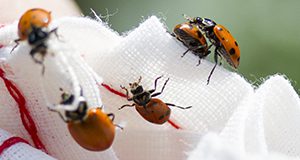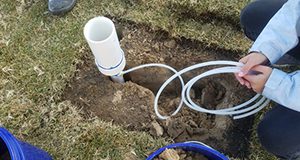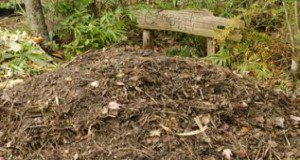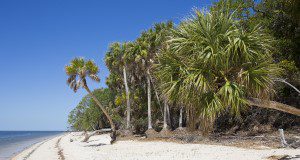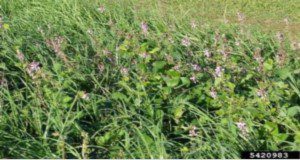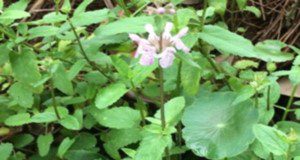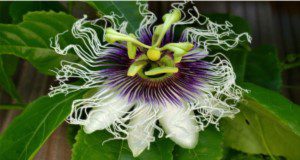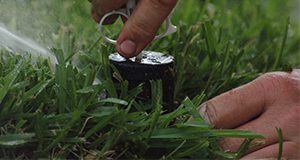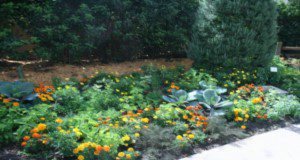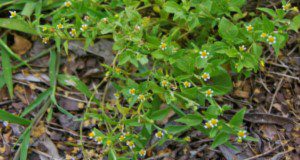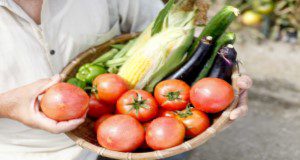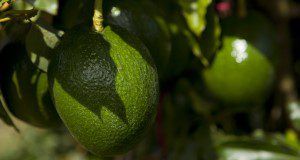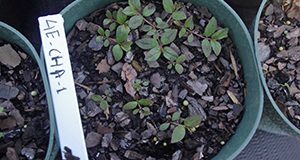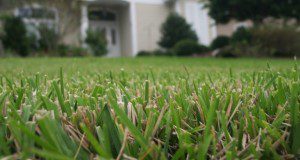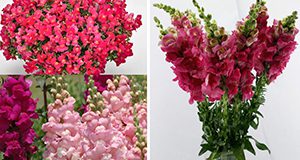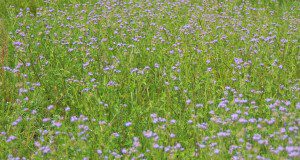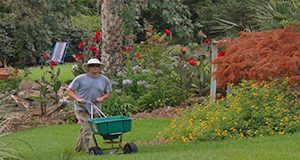This 14-page guide written by Lynn M. LeBeck and Norman C. Leppla and published by the UF/IFAS Entomology and Nematology Department provides assistance in selecting, purchasing and using commercially available natural enemies and biopesticides for managing accurately diagnosed pest problems.
https://edis.ifas.ufl.edu/in849
Category: Lawn & Garden
Design, Construction, and Installation of a Drainage Lysimeter for Use on Sandy, Well-Drained Soils under Turfgrass
Using lysimeters to collect water quality samples can provide a better understanding of nutrient or other solute migration below the surface, which can inform landscape management for environmental protection. This 6-page publication presents the materials, construction, installation, and management of a specific drainage lysimeter design in a step-by-step format. Written by Jovana Radovanovic, Eban Z. Bean, and Alexander J. Reisinger, and published by the UF/IFAS Department of Agricultural and Biological Engineering, February 2021.
https://edis.ifas.ufl.edu/ae554
Recycling Organic Materials to Improve Your Florida-Friendly Edible Landscape
This new 7-page publication of the UF/IFAS Environmental Horticulture Department is intended to educate homeowners on environmentally friendly ways to enhance soil fertility for vegetables, herbs, and fruits in the home landscape. It discusses strategies for recycling nutrients in place or via composting systems to create productive edible landscapes with less waste. Adopting these methods into your landscape maintenance routine will build organic matter and add nutrients to the soil naturally. Written by Terra Freeman, Tiare Silvasy, Lynn Barber, Tom Wichman, Esen Momol, Tina McIntyre, Jacqlyn Rivas, and Jen Marvin.
https://edis.ifas.ufl.edu/ep599
Seeding the Garden
Growing your own Florida vegetable garden can be a rewarding experience with a little planning. This 5-page publication of the UF/IFAS Horticultural Sciences Department presents an overview of proper seed selection and planting. It also provides best management practices, as well as relevant terms and methods, for seeding vegetables in home and community gardens. Written by Danielle Treadwell, David Outerbridge, Tabitha Petri, and James M. Stephens.
https://edis.ifas.ufl.edu/vh026
Lightning Damage to Landscape Palms
Florida is considered by some to be the lightning capital of the world. Florida has on average 3,500 cloud-to-ground lightning strikes per day and 1.2 million strikes per year. Given so many strikes, the probability of damage to certain palms is significant. Coconut palms, royal palms, and Washington palms are particularly vulnerable due to their great heights, but other tall palms may be equally susceptible. This new 6-page publication of the UF/IFAS Environmental Horticulture Department describes and includes many helpful photos of symptoms of lightning damage as well as lightning protection systems. Written by Stephen H. Brown, Douglas Caldwell, and Ralph Mitchell.
https://edis.ifas.ufl.edu/ep598
Consejos Basicos para Disenar Sistemas Eficientes de Riego
Este documento provee un panorama básico de los factores más importantes al diseñar. Written by Haimanote K. Bayabil, Kati W. Migliaccio, Michael Dukes, Laura Vasquez, and Carlos Balerdi, and published by the UF/IFAS Department of Agricultural and Biological Engineering, December 2020.
https://edis.ifas.ufl.edu/ae549
Biology and Management of Creeping Beggarweed (Desmodium incanum) in Warm-Season Turf
Creeping beggarweed is a common perennial broadleaf weed in Florida landscapes, home gardens, pastures, and other agricultural production systems. This new 6-page article is written for green industry professionals and others to help aid in the identification and management of creeping beggarweed in landscape turf and planting beds. Written by Grantly Ricketts and Chris Marble, and published by the UF/IFAS Environmental Horticulture Department.
https://edis.ifas.ufl.edu/ep591
Biology and Management of Florida Betony (Stachys floridana) in Ornamental Plants in Landscape Planting Beds
Florida betony (Stachys floridana) is a perennial weed in Florida landscape planting beds, gardens, turfgrass, and agricultural production systems. This new 4-page article is written for green industry professionals and others to aid in the identification and management of Florida betony in and around ornamental plants in landscape planting beds. Written by Thomas Smith and Chris Marble, and published by the UF/IFAS Environmental Horticulture Department.
https://edis.ifas.ufl.edu/ep597
Passion Fruit Problems in the Home Landscape
In Florida, purple and yellow passion fruit have been widely cultivated by homeowners for years, and south Florida’s subtropical climate allows for growing passion fruit year-round. Many factors affect longevity and productivity of passion fruit vine, including environmental stresses, pests, and disease. This new 5-page document is designed to help Master Gardeners and homeowners by answering commonly asked questions about passion fruit production problems. Written by Amir Rezazadeh, Mark Bailey, and Ali Sarkhosh, and published by the UF/IFAS Horticultural Sciences Department.
https://edis.ifas.ufl.edu/hs1397
Florida H2OSAV Insights: Home Water Use in the Gainesville Regional Utilities (GRU) Service Territory
This 6-page fact sheet discusses basics about water consumption for single-family, detached homes served by Gainesville Regional Utilities, information about the highest water users, and impacts of irrigation on water consumption. Written by Nick Taylor, Kaitlin Olander Robb Price, Bradley Spatz, Tricia Kyzar, and Pierce Jones, and published by the UF/IFAS Department of Agricultural and Biological Engineering, September 2020.
https://edis.ifas.ufl.edu/ae544
Edible Landscaping Using the Nine Florida-Friendly LandscapingTM Principles
Maintaining edible landscapes in a way that protects the environment is an important concern for protecting Florida’s water quality. The objective of this new 7-page publication is to introduce the framework of the Florida-Friendly Landscaping™ principles and apply the principles to guide decisions about Best Management Practices (BMPs) for care of edible landscapes. Written by Tiare Silvasy, Lynn Barber, Esen Momol, Tina McIntyre, Tom Wichman, Gail Hansen, Jen Marvin, Terra Freeman, Joseph Sewards, Wendy Wilber, and Jacqlyn Rivas.
https://edis.ifas.ufl.edu/ep594
Biology and Management of Galinsoga (Galinsoga quadriradiata) in Ornamental Crop Production
Galinsoga (Galinsoga quadriradiata) is an erect (upright), herbaceous, short-lived warm-season annual weed in Florida landscapes, container nurseries, and other agricultural production systems. In nurseries and landscapes, galinsoga can be a troublesome weed, but it has been utilized by some cultures for food or medicinal purposes. This new 5-page article is written for green-industry professionals and others to aid in the identification and management of galinsoga in and around ornamental plants. Written by Thomas Smith, Chris Marble, Shawn Steed, and Nathan Boyd, and published by the UF/IFAS Environmental Horticulture Department.
https://edis.ifas.ufl.edu/ep593
Guía para Cultivar Vegetales en la Florida
El desarrollo y planificación de un huerto en el hogar, es una actividad agrícola que puede realizarse durante todo el año en Florida. Puede ofrecer muchos beneficios para la salud física y emocional. Los huertos nos proveen alternativas para realizar ejercicios, disfrute del huerto, producción de vegetales frescos y nutritivos, ahorro económico y muchos otros. Esta guía proporciona recomendaciones para hacer un huerto en su residencia y comunidad, e incluye las fechas de siembra, la selección de variedades para la planificación de cultivos, el manejo de agua, nutrientes, plagas y la cosecha.
This is a translation of SP103/VH021, Florida Vegetable Gardening Guide. Written by Sydney Park Brown, Danielle Treadwell, J. M. Stephens, and Susan Webb; translated by Francisco Rivera; and published by the UF/IFAS Horticultural Sciences Department.
https://edis.ifas.ufl.edu/hs1383
Recomendaciones para la Detección y Mitigación de la Marchitez del Laurel en Árboles de Aguacates y Especies Relacionadas en Jardines y Patios Hogareños
This is the Spanish translation of HS1358, Recommendations for the Detection and Mitigation of Laurel Wilt Disease in Avocado and Related Tree Species in the Home Landscape. Avocado trees are a popular choice for homeowners in Florida, with over 600,000 growing in Florida home landscapes. However, avocado trees as well as others in the Lauraceae family are susceptible to laurel wilt disease, which can kill a tree in as few as three weeks. This new 8-page publication of the UF/IFAS Horticultural Sciences Department provides home owners recommendations for identifying and mitigating laurel wilt disease in the home landscape. Written by Jonathan H. Crane, Jeff Wasielewski, Daniel Carrillo, Romina Gazis, Bruce Schaffer, Fredy Ballen, and Edwards Evans.
https://edis.ifas.ufl.edu/hs1384
Biology and Management of Garden Spurge (Euphorbia hirta) in Ornamental Crop Production
Garden spurge is a prostrate, herbaceous, short-lived, warm-season annual weed commonly found in Florida landscapes, container nurseries, and other agricultural production areas. This 5-page article is written to aid green industry professionals and others in the identification and management of garden spurge in and around ornamental plants. Written by Thomas Smith, Chris Marble, Shawn Steed, and Nathan Boyd, and published by the UF/IFAS Environmental Horticulture Department, July 2020.
https://edis.ifas.ufl.edu/ep586
Landscaping on or near Septic Drain Fields
Septic systems are common throughout most rural areas, and their care and maintenance are essential to the health of people, wildlife, livestock, agricultural commodities, and water resources. One way to ensure optimal performance of your septic system is to landscape appropriately near the drain field. The purpose of this new 3-page publication of the UF/IFAS Department of Soil and Water Sciences is to provide landscape management guidance for septic system drain fields. Information presented here will be useful for homeowners, landscape management professionals, and Extension agents who work in horticulture, natural resources, agriculture, and family services. Written by Whitney C. Elmore, William Lester, James Moll, Andrea Albertin, and Mary Lusk.
https://edis.ifas.ufl.edu/ss687
Development of a Model Mutagenesis System for Snapdragon
This 4-page document describes the advantages of snapdragon’s elegant transposon mutagenesis system and its connection to plant breeding. Written by Zhaoyuan Lian, Heqiang Huo, Sandra Wilson, and Jianjun Chen, and published by the UF/IFAS Environmental Horticulture Department, August 2020.
https://edis.ifas.ufl.edu/ep584
Biology and Management of Praxelis (Praxelis clematidea) in Ornamental Crop Production
Praxelis is a newly emerging weed species in Florida, one that Plant Protection and Quarantine (PPQ) is considering adding to the federal noxious weed list. The plant can be easily misidentified and confused with Ageratum houstonianum (bluemink) and Conoclinium coelestinum (blue mistflower) as well as several other species that have similar flower characteristics. This new 5-page article is written for green industry professionals and others to aid in the identification and management of praxelis in and around ornamental plants. Written by Yuvraj Khamare, Chris Marble, Shawn Steed, and Nathan Boyd, and published by the UF/IFAS Environmental Horticulture Department.
https://edis.ifas.ufl.edu/ep585
Recommendations for the Detection and Mitigation of Laurel Wilt Disease in Avocado and Related Tree Species in the Home Landscape
Avocado trees are a popular choice for homeowners in Florida, with over 600,000 growing in Florida home landscapes. However, avocado trees as well as others in the Lauraceae family are susceptible to laurel wilt disease, which can kill a tree in as few as three weeks. This new 7-page publication of the UF/IFAS Horticultural Sciences Department provides home owners recommendations for identifying and mitigating laurel wilt disease in the home landscape. Written by Jonathan H. Crane, Jeff Wasielewski, Daniel Carrillo, Romina Gazis, Bruce Schaffer, Fredy Ballen, and Edwards Evans.
https://edis.ifas.ufl.edu/hs1358
Urban Fertilizer Ordinances in the Context of Environmental Horticulture and Water Quality Extension Programs: Frequently Asked Questions
Excess nitrogen (N) and phosphorus (P) in water bodies are a leading cause of water quality degradation statewide. More than 50 Florida counties and municipalities now have formal fertilizer ordinances, which in some cases include fertilizer blackouts, or bans on the usage of N and P fertilizers during certain times of the year. This 8-page document provides information on the underlying issues of fertilizer use, with an emphasis on an urban setting, and outlines the current state of the science on urban fertilizers and water quality in Florida. Written by Michael D. Dukes, Lisa Krimsky, Mary Lusk, Laurie Trenholm, Bryan Unruh, Michelle Atkinson, and Rao Mylavarapu, and published by the UF/IFAS Department of Agricultural and Biological Engineering, February 2020.
https://edis.ifas.ufl.edu/ae534
